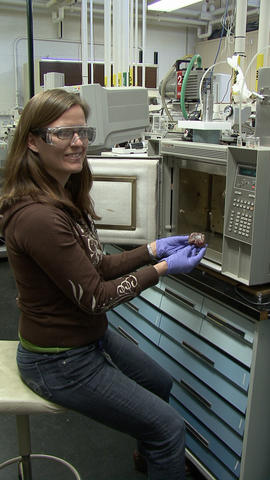
Tara Lovestead prepares a sample of meat (by excising a few milligrams) for testing with a new sampling method developed by NIST researcher Tom Bruno that can detect trace amounts of low volatility compounds produced when perishable foods such as chicken begins to spoil.
Mom's trusty nose may be good, but researchers at the National Institute of Standards and Technology (NIST) have gone her one better by designing an instrument that quickly and precisely sniffs trace amounts of chemical compounds that indicate poultry spoilage without damaging the product itself. The process can detect minute amounts of spoilage compounds and can be used by suppliers during all stages of processing, transport and storage.
Several proactive measures are used in the United States to keep poultry from going bad between the time it leaves the farm to when it reaches your grocery cart. Antibiotics and other chemical additives are commonly used to keep the product from spoiling, but without invasive and time-consuming tests, it's hard to determine if the spoilage process has begun or not.
For several years, detection of volatile organic compounds created when lipids and/or proteins decompose has been used to test for spoilage. The technique developed by NIST research chemists Tom Bruno and Tara Lovestead relies on identifying the much more difficult to detect trace amounts of low volatility compounds that are present early in the decay process. Analyzing such low-volatility compounds used to require impractically long collection times to get a big enough sample for testing and identification.
The key to detecting minute levels of the low volatility compounds produced when chicken spoils is a new method of sampling the "headspace" —the air above a test sample. Bruno devised a technique using a short alumina-coated tube cooled to very low temperatures to promote the adsorption of low-volatility chemicals, a technique called cryoadsorption. (See "Prototype NIST Method Detects and Measures Elusive Hazards," NIST Tech Beat, Sept. 8, 2009.) Among other advantages, Bruno's sampling method is robust and flexible in terms of where and how it can be used, an important feature for the food industry.
Bruno and Lovestead separated and identified six potential chemical markers that could be used to indicate poultry spoilage before it becomes unhealthy. Those markers were found in the air above spoiled chicken breasts, maintained in their original retail packaging and kept at room temperature for two weeks.
Considering that Americans annually consume an average of nearly 84 pounds of chicken each (per 2008 USDA statistics, the most recent year available), this improved testing method for spoilage could have significant health implications.
T.Bruno and T. Lovestead. Detection of poultry spoilage markers from headspace analysis with cryoadsorption on a short alumina PLOT column. Food Chemistry, Volume 121, Issue 4, Aug. 15, 2010, pages 1274-1282.

